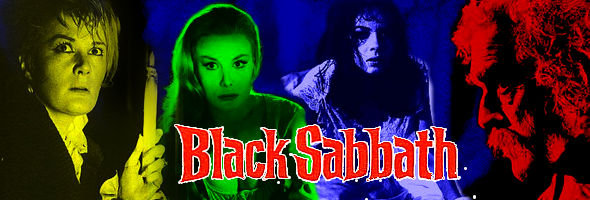

The lost art form of the horror anthology doesn't get much In "The Telephone," voluptuous high class escort girl, Rosy (Mercier) is terrorized by threatening phone calls. Her vicious pimp, Frank, has just been released from prison and may be responsible, so she calls her friend Mary (Alfonsi) for comfort. Obviously, not everyone survives to see the morning. In "The Wurdulak," young journeyman Vladimir (Damon) stumbles upon a decapitated corpse along a mountainous road. Eventually he arrives at a desolate home where a frightened family awaits the return of its patriarch, Gorca (Karloff). That night the head of the household shows up, looking quite spooky and brandishing the severed head of a notorious thief and "wurdulak," a vampire who feeds on the blood of his loved ones. As the night passes, the vampiric threat turns out to be very real indeed. In the film's tour de force, "The Drop of Water," nervous Helen (Pierreux) is called in late at night to prepare the corpse of a recently deceased medium who died during a seance. The ghastly expression on the body's face unnerves Helen, who she still A pure exercise in style that almost makes Bava's official debut Black Sunday look sedate, Black Sabbath is one of the director's greatest achievements and a perfect introduction to his style of filmmaking. Originally shown in Europe as I tre volti della paura (The Three Faces of Fear), the film was released in the United States by American International Pictures under its most famous title in a drastically altered edition featuring alternate Karloff intros, a massive overhaul on "The Telephone" which transformed it into an avenging ghost story, and some mild censorship during The U.S. version turned up as a standalone title in various incarnations in the early days of home video including a U.S. laserdisc double bill with Black Sunday, while the Italian cut floated overseas around without any English subtitles until the first official DVD release from Image back in the early '00s. That release was a major boon to fans of European horror who could finally see the tantalizing Italian version described in detail in a major story from Video Watchdog, and the transfer from the original negative set the pace for how the film would look in future editions as well. The color scheme is definitely warmer and has more of a gold cast than the AIP edition (presumably due to the different color processes utilized for the two markets), while the optional English subtitles seem to get the job done very well. The Image disc also includes an amusing Italian theatrical trailer, which cheerfully reveals all of the film's scariest moments and contains the unique pitch line: "Mercy! Scary!"
A few years later, Anchor Bay licensed the rights to much of the Bava catalog and mounted a pair of box sets slated to include a wealth of new extras. That turned out to be hobbled pretty seriously by the label's late hour decision to scale back on the time and resources allowed, while an announcement that the American version would also be included had to be retracted when that version's owner, MGM, balked and insisted no such thing would come to pass. The resulting DVD was still a step up, almost identical in quality (but with some damage clean up) but augmented with a sterling audio commentary from Tim Lucas, who covers the tangled history of the film's two versions, Bava's cinematic bag of tricks in each of the stories, and the working relationship with Karloff, who soldiered on to do the gag ending despite its possible permanent adverse effects on his health. Also included is a great 21-minute featurette, "A Life in Film," with Mark Damon talking about getting his start in Hollywood, switching to acting in Italy, and eventually becoming a successful producer with diverse films like Monster, The Choirboys, and 9 1/2 Weeks. That doesn't leave much room for extras on the Blu-Ray, which only includes a handy "Twice the Fear" featurette showing visual and aural comparisons between the two versions in each of the stories and the Karloff intros. The second DVD contains the Tim Lucas commentary and Damon featurette along with the Italian and American theatrical trailers, a compact but worthwhile introduction by film writer Alan Jones (which seems like a peculiar choice to leave off the Blu-Ray), a TV spot and a few radio spots, and a liner notes insert booklet containing a Lucas interview with AIP's Samuel Z. Arkoff about the studio's impressive work with Bava and an essay by critic David Cairns. The third DVD sports the AIP cut and the "Twice the Fear" featurette, but go with the Blu-Ray option on that one. A flat out masterpiece of macabre filmmaking and perhaps the greatest of all horror omnibus films, finally available in an edition that does it proud.
In a reversal of the pattern that had been established with previous titles like Black Sunday, Lisa and the Devil, and Baron Blood, the American Blu-Ray and DVD reissue of Black Sabbath came well after the Arrow one, with substantially fewer extras. This time it's practically bare bones, oddly enough, containing only trailers for those other three Bava titles (but not one for the main feature itself). Also gone from the previous U.S. editions are the Lucas commentary and featurette, so how does the transfer (Italian version only) stack up? In a word, weirdly. There's more visual information on all four sides compared to the other transfers, which is definitely a plus, but it's also undergone a very radical change in its color palette. The opening credits, which are normally on the amber side, now look lime green, and the entire film has basically been Matrix-ized with heavy cobalt blues and steely greens tinting the entire feature. This is hardly the first time weird element issues have popped up with the Bava masters delivered for American releases; for example, Five Dolls for an August Moon had its formerly rich, colorful appearance (seen on the Image disc and theatrical prints) turn into a heavy, sickly shade of blue when it hopped over to Anchor Bay, while Bay of Blood and Kill, Baby... Kill! have had problems far too numerous to list here. One can certainly speculate about the source of the transformation here, but for now what we have is another aberration in the Bava filmography for the history books. One thing's for certain: any Bava fans worth their salt who enjoy his work in HD should certainly be ponying up for an all-region player by now. For a comparison, the screen grabs in this review are from the Arrow release, but you can see the first three of them from the Kino disc by clicking here, here, and here.
Directed by Mario Bava
Starring Boris Karloff, Mark Damon, Michèle Mercier, Jacqueline Pierreux, Susy Andersen, Lidia Alfonsi, Harriet Medin White
Kino Lorber (Blu-Ray & DVD) (US RA/R1 HD/NTSC) / WS (1.78:1) (16:9), Arrow (Blu-Ray & DVD) (UK RB/R2 HD/PAL), Anchor Bay, Image (US R1 NTSC), Raro (Italy R2 PAL), Umbrella (Australia R0 PAL) / WS (1.85:1) (16:9)
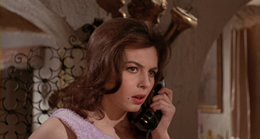 creepier than Black Sabbath, a trilogy of chilling tales from Italian horror maestro Mario Bava. American horror star Boris Karloff made a rare overseas appearance as host of these tales and provided an unforgettable appearance as the lead in one of them, the finest vampire tale in Italian cinema (and one of the best from any country to boot). Bava really proved his versatility here by also providing innovative twists on the ghost story and giallo as well (before it really even got off the ground), delivering a crackerjack film that still delivers scares and dazzles the eye with one visual surprise after another.
creepier than Black Sabbath, a trilogy of chilling tales from Italian horror maestro Mario Bava. American horror star Boris Karloff made a rare overseas appearance as host of these tales and provided an unforgettable appearance as the lead in one of them, the finest vampire tale in Italian cinema (and one of the best from any country to boot). Bava really proved his versatility here by also providing innovative twists on the ghost story and giallo as well (before it really even got off the ground), delivering a crackerjack film that still delivers scares and dazzles the eye with one visual surprise after another.
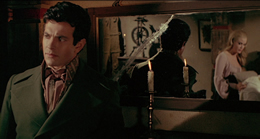 musters the courage to pocket a valuable ring from the dead woman's finger. Meanwhile a fly buzzes nervously around the room, and a repetitive drop of water echoes throughout the room. When Jacqueline returns home, she is terrorized by repeated drops of water... a buzzing fly... and much, much more.
musters the courage to pocket a valuable ring from the dead woman's finger. Meanwhile a fly buzzes nervously around the room, and a repetitive drop of water echoes throughout the room. When Jacqueline returns home, she is terrorized by repeated drops of water... a buzzing fly... and much, much more.
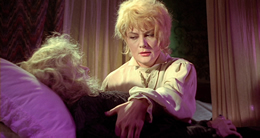 the more graphic moments of "The Wurdulak." Even more drastically, the stories' order was shuffled in the following order: "The Drop of Water," "The Telephone," then "The Wurdulak." The U.S. version is still undeniably effective and has brought about more than a few nightmares among impressionable viewers, but the Italian version is more coherent and has essentially become the default first viewing experience for many viewers now based on its widespread release on DVD. Of course, the American edition still has the major trump card of Karloff's warm, familiar voice, not to mention one of the best AIP scores from composer Les Baxter (replacing the sparse Italian work by Roberto Nicolosi). It's tempting to wonder whether the AIP edition at one point included Karloff's jokey coda to the film (preserved in the Italian version) given Baxter's otherwise inexplicable shift to rollicking circus music for the end credits, which otherwise comes off as some kind of odd apology for the incredibly dark note that closes the
the more graphic moments of "The Wurdulak." Even more drastically, the stories' order was shuffled in the following order: "The Drop of Water," "The Telephone," then "The Wurdulak." The U.S. version is still undeniably effective and has brought about more than a few nightmares among impressionable viewers, but the Italian version is more coherent and has essentially become the default first viewing experience for many viewers now based on its widespread release on DVD. Of course, the American edition still has the major trump card of Karloff's warm, familiar voice, not to mention one of the best AIP scores from composer Les Baxter (replacing the sparse Italian work by Roberto Nicolosi). It's tempting to wonder whether the AIP edition at one point included Karloff's jokey coda to the film (preserved in the Italian version) given Baxter's otherwise inexplicable shift to rollicking circus music for the end credits, which otherwise comes off as some kind of odd apology for the incredibly dark note that closes the 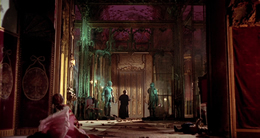 feature.
feature.
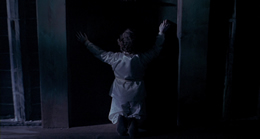
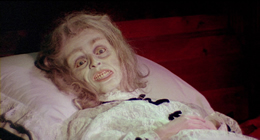 For years it seemed unlikely the AIP edition would ever get a legitimate home video release after its ancient VHS and laserdisc days, though it did pop up in an attractive hi-def rendering on channels like MGM HD and Epix. Fortunately a welcome twist of fate came along with the 2013 United Kingdom release from Arrow, which packs in three discs (one Blu-Ray, two DVDs). The Blu-Ray contains both cuts of the film in attractive 1080p transfers; the Italian cut features color timing essentially identical to the previous versions, but the leap in detail and sharpness is obvious right off the bat. The other colors fare better here as well, especially the impressionistic splashes of purple, green, and red lighting Bava often uses to create depth within the frame. The DTS-HD mono audio for both versions sounds excellent, with English subtitles for the Italian one and optional subtitles for the deaf and hard of hearing on the AIP one. Interestingly, the AIP version (which bears the MGM logo) is framed differently, with some slight vertical squeezing pushing some information off from the left and right sides compared to the Italian one. Apparently this was an odd printing decision made back when that cut was being prepared, and while you'd never notice it unless both versions were playing at once for comparison, it's worth noting. (For the record, there's a very miniscule sliver of additional information visible in the old DVD version, but it doesn't affect the presentation one way or the other at all.) The Blu-Ray designates a healthy bit rate to both cuts, and interestingly, it's now obvious that the significantly grainier AIP version had some pretty significant noise reduction applied for its HD broadcasts. For a comparison between the two versions on the Blu-Ray, check out this shot from the Italian version and this one from the American cut.
For years it seemed unlikely the AIP edition would ever get a legitimate home video release after its ancient VHS and laserdisc days, though it did pop up in an attractive hi-def rendering on channels like MGM HD and Epix. Fortunately a welcome twist of fate came along with the 2013 United Kingdom release from Arrow, which packs in three discs (one Blu-Ray, two DVDs). The Blu-Ray contains both cuts of the film in attractive 1080p transfers; the Italian cut features color timing essentially identical to the previous versions, but the leap in detail and sharpness is obvious right off the bat. The other colors fare better here as well, especially the impressionistic splashes of purple, green, and red lighting Bava often uses to create depth within the frame. The DTS-HD mono audio for both versions sounds excellent, with English subtitles for the Italian one and optional subtitles for the deaf and hard of hearing on the AIP one. Interestingly, the AIP version (which bears the MGM logo) is framed differently, with some slight vertical squeezing pushing some information off from the left and right sides compared to the Italian one. Apparently this was an odd printing decision made back when that cut was being prepared, and while you'd never notice it unless both versions were playing at once for comparison, it's worth noting. (For the record, there's a very miniscule sliver of additional information visible in the old DVD version, but it doesn't affect the presentation one way or the other at all.) The Blu-Ray designates a healthy bit rate to both cuts, and interestingly, it's now obvious that the significantly grainier AIP version had some pretty significant noise reduction applied for its HD broadcasts. For a comparison between the two versions on the Blu-Ray, check out this shot from the Italian version and this one from the American cut.
Updated review on June 30, 2013.
![]()